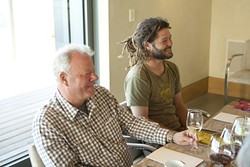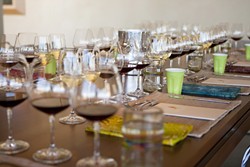Last week I wrote about the history of Santa Maria Valley wine country after taking an in-depth tour of the wineries and vineyards, designed for the media. This week, I’ll cover some great wines from the valley’s longtime winemakers and introduce you to new brands that every wine lover should want to know about.

- PHOTO BY STEVE E. MILLER
- TO THE FUTURE : Winemaker Dieter Cronje and Madison Murphy, owner of Presqu’ile winery, believe it represents the future of winemaking in the Santa Maria Valley.
While touring the wine country trails with publicist Sao (pronounced Song) Anash of Muse Management, we visited historical parts of Santa Maria Valley wine country that I’ve driven past hundreds of times, yet never visited. Particularly poignant was our stop at the San Ramon Chapel on Foxen Canyon Road. The historic church and vineyard has the tombstone of William Benjamin Foxen, whose anchor cattle brand became the trademark for Foxen Vineyards. Great-great grandfather of Foxen co-owner Dick Dore, Foxen purchased Rancho Tinaquaic in 1837. The Mexican land grant comprised most of what’s now the Foxen Canyon. We also saw the tombstone of Don Juan Pacifico Ontiveros, who purchased the Rancho Tepusquet Land Grant in 1855. Visiting the chapel is a must for any history buff.
We tasted wines from brands with a long, esteemed history in Santa Maria Valley. Riverbench produced delightful 2009 sparkling blanc de blanc, 2009 Chardonnay, and 2008 Pinot Noir from their estate, 30-year-old vineyard that’s SIP (sustainable in practice) certified. You can taste these wines at the craftsman-style home that’s their new tasting room at 6020 Foxen Canyon Road. From Foxen Vineyard, we tasted extraordinary wines from Bien Nacido Vineyard-grown grapes, a 2009 Pinot Noir from Block 8 and 2010 Chardonnay Block UU. These noteworthy wines are currently available at Foxen’s tasting room at 7600 Foxen Canyon Road. When you grow great wines, you deserve a brand. Watch for upcoming brands by the Miller family named for their outstanding vineyards: Solomon and Bien Nacido.
I was excited about the region’s newest brands: the expressive Alta Maria 2009 Chardonnay and 2009 Pinot Noir, and the Native9 2009 Pinot Noir we tasted with vintner James Ontiveros (his day job is director of sales and marketing for Bien Nacido Vineyard). Alta Maria, devoted to fine Chardonnays and Pinot Noirs, is made in partnership with winemaker Paul Wilkins, who befriended Ontiveros when they both attended Cal Poly. Native9 reflects Ontiveros as a ninth-generation farmer in Santa Maria Valley. His small, eight-acre, Rancho Ontiveros Vineyard is planted exclusively to Pinot Noir. The 2009, his second vintage, exhibits the delicious fruit and spice characteristics found only in Santa Maria Valley. Ontiveros explained that his family’s ranch almost butts up to the original land grant purchased by his ancestor. In subsequent years, the family lost the land that’s now Bien Nacido Vineyard. You’ll find Alta Maria and Native9 wines in their Los Olivos tasting room at 2933 Grand Ave.

- PHOTO BY STEVE E. MILLER
Our last visit was to the newest winery at 2540 Clark Ave., which Anash described to us as “the future of Santa Maria Valley wine country,” Presqu’ile. President and co-owner Matt Murphy explained the unusual name is Creole, meaning, “almost an island.” Presqu’ile described a small town on the Gulf Coast, devastated by Hurricane Katrina, where generations of the Murphy family gathered every summer. Today, Presqu’ile in Santa Maria Valley draws this southern family together again. They’re building a state-of-the-art winery they expect to open by early 2013. Set on the highest hilltop, visitors will experience spectacular panoramic views of the Santa Maria Valley and the Pacific Ocean, and taste their extraordinary wines by winemaker Dieter Cronje: “I have a philosophy on winemaking, and I guess it’s as much to steer away from the recipe style of making wine where you would do everything similar every year,” Cronje explained candidly of his “varietally correct wines.”
“We tend to believe here that Mother Nature does not give us the same grapes every year—not in any way possible,” he said. “It’s always different. So for us, we tend to want to stand back to see what mother nature gives us and then do justice toward that product in the winery.”
They poured an impressive lineup from the 2010 Sauvignon Blanc and 2009 Chardonnay to the three distinctively different 2009 Pinot Noirs. Although they’re not open for public tastings yet, the Murphys are opening a Los Olivos tasting room in February 2012. The wines are available online at presquilewine.
Too many vineyards?
A consumer recently asked me: “We have a lot of vineyards, they’re pretty and all that, but don’t you think we have too many?” I emphatically responded: No. Frankly, we aren’t close to capacity. According to the 2010 statistics by the California wineries and vineyards advocacy group, the Wine Institute, on American Viticultural Areas (AVA), Santa Maria Valley has 80,000 acres of winegrapes, hardly comparable to the number of acres within Napa Valley at 225,280 acres, or Sonoma Coast at 480,000 acres. Those acreage numbers only count those specific sub-AVAs; there are many more acres within each county. We can count on more growth all over the Central Coast, and it will better serve our small town communities.
Our wineries are major contributors to the community. They provide jobs and hands-on work experiences for college students, and they’re extremely generous in contributions to local charities. In fact, some wineries created charities specifically for farmworkers to provide free health care. Yet there is still plenty of room for more artisan farms, specialty food purveyors, and ranches. The Central Coast food and wine scene is booming thanks to the attention of popular publications like Sunset magazine and The New York Times, the latter of which proclaimed Paso Robles as “the new Napa Valley.” Wine connoisseurs have visited the Central Coast for three decades, attracted by our many talented, artisan winemakers producing amazing wines. Too many wineries and vineyards? I say it’s not possible.
Contact New Times’ Cuisine columnist at [email protected].


Comments